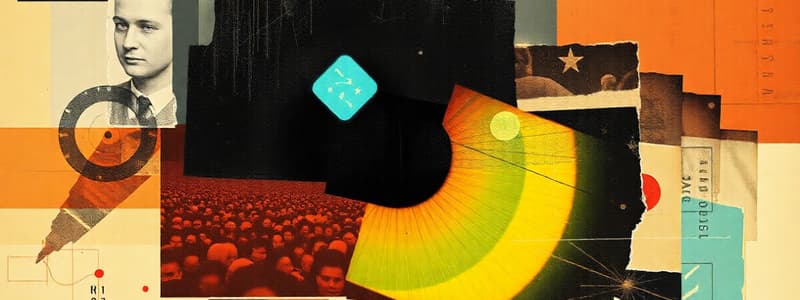Podcast
Questions and Answers
What does the term 'saturation' refer to in the context of color dimensions?
What does the term 'saturation' refer to in the context of color dimensions?
- The intensity or luminance of a color, from dark to light.
- The spatial arrangement of colors based on their perceived relationships
- The purity of a color, ranging from gray to vivid. (correct)
- The color itself, as it changes around the color circle.
According to the CIE chromaticity diagram, where are the most saturated colors located?
According to the CIE chromaticity diagram, where are the most saturated colors located?
- At the center of the diagram.
- Along the straight lines connecting any two primary wavelengths.
- Along the perimeter of the curve, also known as the spectral locus. (correct)
- Near the neutral or white (W) point.
What does the straight line connecting two primary wavelengths on the CIE chromaticity diagram represent?
What does the straight line connecting two primary wavelengths on the CIE chromaticity diagram represent?
- The progression from dark to light.
- The range of colors produced by mixing those two wavelengths. (correct)
- The complementary colors of the spectrum.
- The area where saturation is highest.
In the context of a computer monitor's color production, what does the triangle formed by the primary colors R, G, and B represent?
In the context of a computer monitor's color production, what does the triangle formed by the primary colors R, G, and B represent?
Which of the following is NOT considered a basic or primary color according to the content?
Which of the following is NOT considered a basic or primary color according to the content?
What is the primary role of the macula lutea in the eye?
What is the primary role of the macula lutea in the eye?
According to the principle of univariance, why can a single photoreceptor not differentiate between changes in wavelength and intensity?
According to the principle of univariance, why can a single photoreceptor not differentiate between changes in wavelength and intensity?
What is the Purkinje effect or shift?
What is the Purkinje effect or shift?
In a standard human retina, what is the approximate ratio of long (L), medium (M), and short (S) wavelength cone photoreceptors?
In a standard human retina, what is the approximate ratio of long (L), medium (M), and short (S) wavelength cone photoreceptors?
What is a key distinction between additive and subtractive color mixing?
What is a key distinction between additive and subtractive color mixing?
What is the consequence of the human visual system representing colour using only three cones?
What is the consequence of the human visual system representing colour using only three cones?
In a colour matching experiment, what does it mean when two fields are a ‘pair of metamers’?
In a colour matching experiment, what does it mean when two fields are a ‘pair of metamers’?
Why do illuminant metameric failures occur?
Why do illuminant metameric failures occur?
Which statement accurately describes the distribution of blue cones in the retina?
Which statement accurately describes the distribution of blue cones in the retina?
What is the minimum number of wavelengths needed to match colors by individuals with normal colour vision?
What is the minimum number of wavelengths needed to match colors by individuals with normal colour vision?
What condition is characterized by individuals having a reduced sensitivity to red light?
What condition is characterized by individuals having a reduced sensitivity to red light?
Which type of colour deficiency is inherited as an autosomal trait?
Which type of colour deficiency is inherited as an autosomal trait?
What is the prevalence of congenital Deuteranomaly among affected males?
What is the prevalence of congenital Deuteranomaly among affected males?
What visual assessment tool uses pseudo chromatic plates to diagnose colour vision deficiencies?
What visual assessment tool uses pseudo chromatic plates to diagnose colour vision deficiencies?
Which of the following statements about monochromacy is accurate?
Which of the following statements about monochromacy is accurate?
What is a characteristic of Tritan deficiency?
What is a characteristic of Tritan deficiency?
Which of the following ocular conditions is not typically associated with acquired colour vision deficiency?
Which of the following ocular conditions is not typically associated with acquired colour vision deficiency?
In terms of genetic inheritance, how is congenital Protan colour vision deficiency inherited?
In terms of genetic inheritance, how is congenital Protan colour vision deficiency inherited?
What is the primary function of the three cone classes in colour detection?
What is the primary function of the three cone classes in colour detection?
Hering's Colour Opponent Theory suggests that which pairs of colours oppose each other?
Hering's Colour Opponent Theory suggests that which pairs of colours oppose each other?
What defines a person with red-green colour deficiency?
What defines a person with red-green colour deficiency?
Which location is responsible for processing information regarding form and colour through parvocellular neurones?
Which location is responsible for processing information regarding form and colour through parvocellular neurones?
What behaviour is associated with colour opponency at the level of retinal ganglion cells?
What behaviour is associated with colour opponency at the level of retinal ganglion cells?
In cortical processing, what happens in the V1 and V2 areas regarding receptive fields?
In cortical processing, what happens in the V1 and V2 areas regarding receptive fields?
Which mechanism is not part of the two stages of colour processing described?
Which mechanism is not part of the two stages of colour processing described?
What is the key factor leading to colour deficiencies?
What is the key factor leading to colour deficiencies?
Flashcards
Lightness
Lightness
The intensity or brightness of a color, ranging from dark to light.
Saturation
Saturation
The purity or vividness of a color, ranging from gray to a pure, strong color.
Hue
Hue
The actual name of a color, like red, green, or blue. It changes around a circle.
CIE Chromaticity Diagram
CIE Chromaticity Diagram
Signup and view all the flashcards
Trichromatic Theory of Color Vision
Trichromatic Theory of Color Vision
Signup and view all the flashcards
Duplicity Theory of Vision
Duplicity Theory of Vision
Signup and view all the flashcards
Dark Adaptation
Dark Adaptation
Signup and view all the flashcards
Rods
Rods
Signup and view all the flashcards
Protanomaly
Protanomaly
Signup and view all the flashcards
Cones
Cones
Signup and view all the flashcards
Purkinje Shift
Purkinje Shift
Signup and view all the flashcards
Deuteranomaly
Deuteranomaly
Signup and view all the flashcards
Blue-yellow Colour Deficiency
Blue-yellow Colour Deficiency
Signup and view all the flashcards
Macula Lutea
Macula Lutea
Signup and view all the flashcards
Tritanomaly
Tritanomaly
Signup and view all the flashcards
Color Vision
Color Vision
Signup and view all the flashcards
Metamers
Metamers
Signup and view all the flashcards
Monochromacy
Monochromacy
Signup and view all the flashcards
Protan
Protan
Signup and view all the flashcards
Principle of Univariance
Principle of Univariance
Signup and view all the flashcards
Additive Color Mixing
Additive Color Mixing
Signup and view all the flashcards
Deutan
Deutan
Signup and view all the flashcards
Tritan
Tritan
Signup and view all the flashcards
Hering's Opponent Color Theory
Hering's Opponent Color Theory
Signup and view all the flashcards
S-Cone
S-Cone
Signup and view all the flashcards
M-Cone
M-Cone
Signup and view all the flashcards
L-Cone
L-Cone
Signup and view all the flashcards
Red-Green Colour Deficiency
Red-Green Colour Deficiency
Signup and view all the flashcards
Double Opponent Receptive Field
Double Opponent Receptive Field
Signup and view all the flashcards
Cortical Processing (V1, V2, V4)
Cortical Processing (V1, V2, V4)
Signup and view all the flashcards
Parvocellular Neuron
Parvocellular Neuron
Signup and view all the flashcards
Study Notes
Colour Vision
- Photoreceptor Types: There are two main classes of photoreceptors, as shown by the duplicity theory of vision.
- Light Adaptation: Faster than dark adaptation.
- Dark Adaptation: The slow recovery of visual sensitivity in low light after exposure to bright light. This process depends on the regeneration of rod pigment.
- Rod Function: Rods operate primarily in dim light conditions (mesopic and scotopic levels).
- Visible Light Spectrum: The human eye responds to wavelengths between 360-760 nm , producing different colour sensations.
- White Light Composition: White light or sunlight is composed of many different wavelengths.
- Colour Perception: Colour is perceived by the interaction of light wavelengths with the eyes.
- Additive Colour Mixing: Mixing different wavelengths of light creates new colours.
- Subtractive Colour Mixing: Mixing pigments subtracts wavelengths of light creating new colours.
- Spectral Sensitivity: Cones have sensitivity peaks at different wavelengths (long, medium, short).
- L/M/S cones: Different cone types respond to different wavelengths allowing for colour discrimination. (L:M:S = 8:4:1).
Cone Distribution
- Cone types: 5-10% of cones in eyes are blue cones.
- Red/Green Ratio: Ratio of red and green cones is approximately 2:1.
- Cone distribution in fovea: Mostly densely packed near the centre
- Randomly mixed: Small patches of cones are clustered randomly.
- Cone colour experiments: The observer adjusts the amount of mixed wavelengths to match a single wavelength colour.
Colour Matching
- Metamers: Two objects can appear the same colour even if their spectral power distributions are different.
- Human visual system: Represents and processes colour using three cones reducing colour inputs to a code of three sensory outputs.
- Cone absorption spectra: The principle of univariance dictates that a single photoreceptor cannot distinguish between different wavelengths.
- How to describe colours: Basic colours such as red, yellow, green, and blue, and combinations of these in a circle showing perceptual relationships.
CIE Chromaticity Diagram
- CIE (International Commission on Illumination): Standardization of colour representation.
- Chromatic colour representation: 2D representation of hues and saturation (saturation decreases towards white point).
- Pure spectral colours: Are along the perimeter of the curve.
- Additive mixture of wavelengths: Straight line connecting the two wavelengths on the diagram.
- Complementary colours: On opposite ends of the diagram.
Trichromatic Theory
- Three cone types: S, M, and L cones (short, medium, long wavelength absorption).
- Responses across cone types: Responsible for perception of a broad range of colours.
- Cone spectral sensitivity: Relative amount of light per wavelength absorbed by each type of cone.
Hering's Colour Opponent Theory
- Opponent colour responses: Blue-Yellow and Red-Green (opponent colour mechanisms).
- Retinal ganglion cells maintain circular opponent receptive fields.
- V1 and V2:Maintain circular colour opponent receptive fields.
- V4 (ventral pathway): Colour-selective cells.
Colour Deficiencies
- Inherited: Common, often genetic or hereditary.
- Red-Green deficiencies: Most prevalent, difficulty distinguishing between red and green.
- Protanomaly: Reduced red cone sensitivity.
- Deuteranomaly: Reduced green cone sensitivity.
- Tritanomaly: Reduced blue cone sensitivity.
- Monochromacy: Extreme cases of colour blindness (only one cone type functioning).
- Colour matching tests: Tools used for assessment of colour vision
- Ishihara plates: A widely used test that consists of coloured plates for diagnostics.
Studying That Suits You
Use AI to generate personalized quizzes and flashcards to suit your learning preferences.




